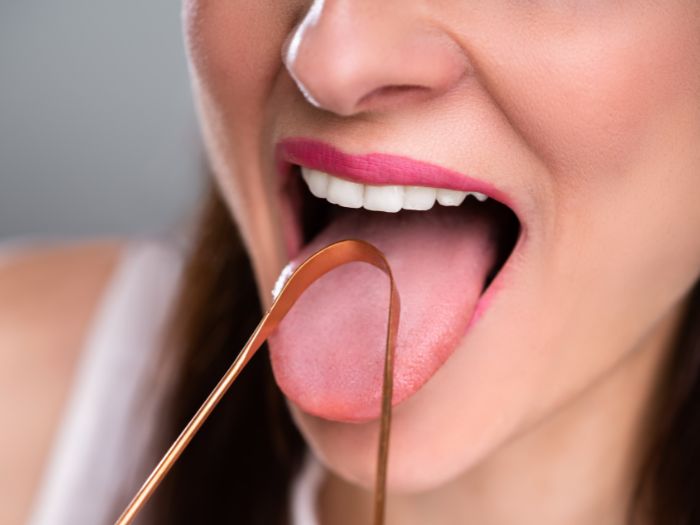What Your Tongue Should Look Like
The tongue has several small bumps called the papillae and color varies from light to dark pink. At a glance, this muscular organ should have a slightly rough, wet appearance.
Considering the tongue sits at the center of your teeth, bacteria can migrate over. In terms of oral care, you’re advised to brush your tongue at the same time as your teeth and check it’s appearance in the mirror. If something looks abnormal, schedule an appointment to discuss any warning signs and symptoms with your dentist.
Concerning Tongue Symptoms
Physical changes to the tongue can indicate a variety of health issues. Look for the following shifts inside your mouth.
White Spots
White spots can indicate a number of concerning conditions. If they have a wet or creamy appearance, you may have a type of fungal infection called thrush that occurs from an imbalance of mouth bacteria. A lace-like appearance can indicate lichen planus, a sign of a more concerning autoimmune disorder that causes your body to attack its mouth tissue.
If the bumps feel hard and have a flat appearance that you cannot rub away, they may be leukoplakia – a precancerous condition that can emerge from tobacco or alcohol use. A tongue that looks too white or light in color can indicate dehydration.
Bumps
Based on location, bumps larger than the typical papillae may be one of the following:
- Transient lingual papillitis, or small, red bumps closer to the tip that often occur in response to irritation.
- Canker sores, which can form on the lower side of the tongue and have a dark reddish appearance.
- A virus resulting in multiple small bumps covering your tongue.
Most conditions resolve themselves but if the bumps remain, cause you pain or grow in size, contact your dentist.
Soreness
You may feel some soreness after an injury to the face or accidentally biting down on your tongue. However, soreness that doesn’t go away can be a sign of canker sores, thrush, an autoimmune condition, an infection or geographic tongue, when the papillae shed their hairs. Soreness can also be a medication side effect or a sign of oral cancer, if accompanied by white or red growths.
Hairy Tongue
This condition describes the buildup of dead skin cells on the tongue, which take on a black, brown or white fur-like appearance. These accentuate the papillae bumps and attached hair, which traps food, bacteria and other substances in the process. Development tends to be linked with lax oral care.
Your tongue may also appear black after using a bismuth-based antacid. While this can be scraped off, persistent growths may indicate leukoplakia or HIV.
Red Tongue
A bright red tongue can be a sign that your body is not receiving enough vitamin B3. It may also be more a more serious symptom of scarlet fever or Kawasaki disease, a condition resulting in blood vessel inflammation.
A Burning Sensation
Eating or drinking something hot or very acidic can cause a burning sensation. Yet if the sensation persists, it can indicate a nervous system issue, acid reflux, dry mouth or diabetes.
Shiny Tongue
By default, your tongue should have a somewhat bumpy appearance. A tongue that appears too smooth, overly shiny and glossy can be a sign of:
- A fungal infection
- Iron, folic acid, or B vitamin deficiency
- Celiac disease
- A medication side effect
- Geographic tongue
- Psoriasis
Fissures
With age, you may spot deeper indents on your tongue, which can trap bacteria and require more attention during your oral care routine. They may also indicate Sjögren’s syndrome, an autoimmune condition causing the body to attack its saliva and tear-production systems.
Mouth Cancer
Early signs of mouth cancer include leukoplakia, or hard, white bumps or patchy growths on the tongue accompanied by irritation. Risks increase after years of smoking or tobacco use.
Leukoplakia does not always evolve into cancer. However, certain signs indicate potentially cancerous growths, including persistent sores, visible lumps, tongue pain and difficulty chewing or swallowing that lasts for over two weeks.
How to Care for Your Tongue
When it comes to maintaining good oral health, don’t forget about your tongue:
- Brush your tongue from back to front to remove bacteria that can exacerbate cavities, gum disease and bad breath.
- Occasionally use a tongue scraper, designed to remove bacteria and the layer of mucus covering your tongue for a more thorough clean.
- Rinse after cleaning your tongue with water or a saline solution.
- Periodically check the color and consistency of your tongue.
- Drink water or green tea throughout the day to wash away debris, stay hydrated and control bacteria that could be living on your tongue.
Are you interested in discussing your oral care routine with a dentist? Contact our Shelton office today.

